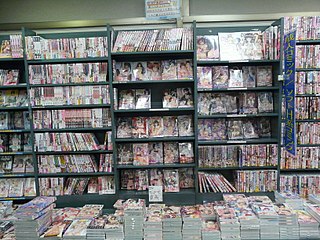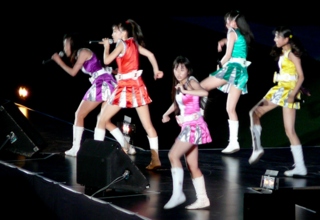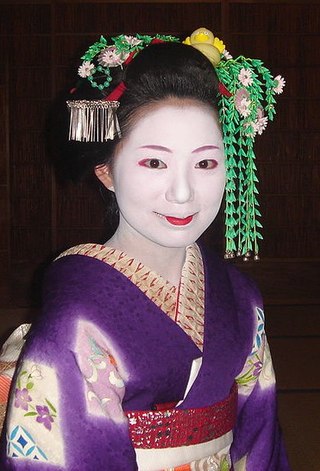
Hentai is a style of Japanese pornographic anime and manga. In addition to anime and manga, hentai works exist in a variety of media, including artwork and video games.

Shotacon, abbreviated from Shōtarō complex, is, in Japanese contexts, the attraction to young boy characters, or media centered around this attraction. The term refers to a genre of manga and anime wherein prepubescent or pubescent male characters are depicted in a suggestive or erotic manner, whether in the obvious role of object of attraction, or the less apparent role of "subject".

In Japan, pornography has unique characteristics that readily distinguish it from western pornography. Pornographic films are known as "adult videos" (AV) in Japan, so Japanese adult videos (JAV) refers to the Japanese pornographic film industry. Animated films are referred to as hentai in English, but in Japan the terms "adult anime" and "erotic animation" are used. In addition to pornographic videos and magazines featuring live actors, there are now categories of pornographic manga and anime, and pornographic computer games.

In Japanese popular culture, lolicon is a genre of fictional media which focuses on young girl characters, particularly in a sexually suggestive or erotic manner. The term, a portmanteau of the English words "Lolita" and "complex", also refers to desire and affection for such characters, and fans of such characters and works. Associated with unrealistic and stylized imagery within manga, anime, and video games, lolicon in otaku culture is generally understood as distinct from desires for realistic depictions of girls, or real girls as such, and is associated with the concept of moe, or feelings of affection and love for fictional characters as such.

Pornography has been dominated by a few pan-European producers and distributors, the most notable of which is the Private Media Group that successfully claimed the position previously held by Color Climax Corporation in the early 1990s. Most European countries also have local pornography producers, from Portugal to Serbia, who face varying levels of competition with international producers. The legal status of pornography varies widely in Europe; its production and distribution are illegal in countries such as Ukraine, Belarus and Bulgaria, while Hungary has liberal pornography laws.
New York v. Ferber, 458 U.S. 747 (1982), was a landmark decision of the U.S Supreme Court, unanimously ruling that the First Amendment to the United States Constitution did not protect the sale or manufacture of child sexual abuse material and that states could outlaw it.
Child erotica is non-pornographic material relating to children that is used by any individuals for sexual purposes. It is a broader term than child pornography, incorporating material that may cause sexual arousal such as nonsexual images, books or magazines on children or pedophilia, toys, diaries, or clothes. Law enforcement investigators have found that child erotica is often collected by pedophiles and child sexual abuse offenders. It may be collected as a form of compulsive behavior and as a substitute for illegal underage pornography and is often a form of evidence for criminal behavior.

A junior idol, also known as a chidol or low teen idol, is a type of entertainers under the age of 18 or 16 who are manufactured and marketed for their image, attractiveness and personality. It is a sub-category of the idol culture in Japanese pop entertainment. Junior idols are primarily gravure idols who are marketed through photo books and image DVDs, but some are also trained in singing and acting. Unlike other child models, idols are commercialized through merchandise and endorsements by talent agencies, while maintaining an emotional connection with a passionate consumer fan base.
Section 63 of the Criminal Justice and Immigration Act 2008 is a law in the United Kingdom criminalising possession of what it refers to as "extreme pornographic images". The law came into force on 26 January 2009. The legislation was brought in following the murder of Jane Longhurst by a man who was said at the time of his trial to have had "extreme pornography" in his possession at the time of the death. The law has been more widely used than originally predicted, raising concerns as to whether the legislation is being used for prosecutions beyond the scope originally envisaged by parliament.
Legal frameworks around fictional pornography depicting minors vary depending on country and nature of the material involved. Laws against production, distribution and consumption of child pornography generally separate images into three categories: real, pseudo, and virtual. Pseudo-photographic child pornography is produced by digitally manipulating non-sexual images of real minors to make pornographic material. Virtual child pornography depicts purely fictional characters. "Fictional pornography depicting minors", as covered in this article, includes these latter two categories, whose legalities vary by jurisdiction, and often differ with each other and with the legality of real child pornography.
Much of the regulation in the adult film industry has been limited to preventing child pornography. To enforce the age of entry restriction, most adult industry production companies are required to have a Custodian of Records that documents and holds records of the ages of all performers.

In the United States, child pornography is illegal under federal law and in all states and is punishable by up to life imprisonment and fines of up to $250,000. U.S. laws regarding child pornography are virtually always enforced and amongst the harshest in the world. The Supreme Court of the United States has found child pornography to be outside the protections of the First Amendment to the United States Constitution. Federal sentencing guidelines on child pornography differentiate between production, distribution, and purchasing/receiving, and also include variations in severity based on the age of the child involved in the materials, with significant increases in penalties when the offense involves a prepubescent child or a child under the age of 18. U.S. law distinguishes between pornographic images of an actual minor, realistic images that are not of an actual minor, and non-realistic images such as drawings. The latter two categories are legally protected unless found to be obscene, whereas the first does not require a finding of obscenity.
Simulated child pornography is child pornography depicting what appear to be minors but which is produced without their direct involvement.
Section 163.1 of the Criminal Code of Canada forbids the production, distribution, and possession of child pornography, which are punishable by a maximum of ten or fourteen years of imprisonment depending on the offense. Portions of the law concerning one-year mandatory minimums for possession and making of child pornography have since been struck down as unconstitutional.
The Australian law prohibits all sexual depictions of children under an age set by state and territory legislation. The relevant ages are under 16 in the Australian Capital Territory, New South Wales, Queensland and Western Australia, under 17 in South Australia, and under 18 in the other jurisdictions and under federal law. The laws covering child pornography are differently defined in the various Australian jurisdictions, as are the penalties. The laws also cover depictions of sexual acts involving people over the threshold age who are simulating or otherwise alluding to being underage, even if all those involved are of a legal age. People have been successfully prosecuted after describing acts of abuse via MMS.
Child pornography is illegal in most countries, but there is substantial variation in definitions, categories, penalties, and interpretations of laws. Differences include the definition of "child" under the laws, which can vary with the age of sexual consent; the definition of "child pornography" itself, for example on the basis of medium or degree of reality; and which actions are criminal. Laws surrounding fictional child pornography are a major source of variation between jurisdictions; some maintain distinctions in legality between real and fictive pornography depicting minors, while others regulate fictive material under general laws against child pornography.
Child pornography is erotic material that depicts persons under the age of 18. The precise characteristics of what constitutes child pornography varies by criminal jurisdiction.

Sexuality in Japan developed separately from that of mainland Asia, as Japan did not adopt the Confucian view of marriage, in which chastity is highly valued. Monogamy in marriage is often thought to be less important in Japan, and sometimes married men may seek pleasure from courtesans. Prostitution in Japan has a long history, and became especially popular during the Japanese economic miracle, as evening entertainments were tax-deductible. Decreased sex drive in the 21st century has been blamed for the low Japanese birth rate and declining growth of the Japanese population.
United States v. Handley, 564 F. Supp. 2d 996 (2008), was a court case in the United States District Court for the Southern District of Iowa involving obscenity charges stemming from the importation of manga featuring pornographic depictions of fictional minors.
E-Hentai is an image-hosting and file-sharing website focused on hentai. The site hosts user-generated image galleries primarily of pornographic content originating or derived from anime, manga, and video games, such as fanart, scanlations of manga and dōjinshi, and cosplay photographs. Its sister site Exhentai was spun off from E-Hentai in 2010 to host artwork that depicts material that is illegal in certain jurisdictions, such as lolicon, shotacon, and bestiality.







